#Encyclopedia.com
Text
Bas-rhin via Encyclopedia.com
#Bas-rhin#Encyclopedia.com#Ancestral Connections#Germanic Folk Tradition#Bookshelf#Tumblr Staff Has Ruined Links Now And I Hate Them For It
0 notes
Text
HIEROPHANY
HIEROPHANY (from Greek hiero-, "sacred," and phainein, "to show") is a term designating the manifestation of the sacred. The term involves no further specification. Herein lies its advantage: It refers to any manifestation of the sacred in whatever object throughout history. Whether the sacred appear in a stone, a tree, or an incarnate human being, a hierophany denotes the same act: A reality of an entirely different order than those of this world becomes manifest in an object that is part of the natural or profane sphere.
The sacred manifests itself as a power or force that is quite different from the forces of nature. A sacred tree, for instance, is not worshiped for being a tree. Neither is a sacred stone adored, in and of itself, for its natural properties as a stone. These objects become the focus of religious veneration because they are hierophanies, revealing something that is no longer botanical or geological, but "wholly other."
45 notes
·
View notes
Text
What Is and Isn't a Fish: an Essay and Guide by Fishyfishyfishtimes
A simplified list of the animals I discuss can be found here!
Hello folks! I created this post to have a kind of definitive essay/explanation of what is and isn't a "fish", starting with defining the term and going over animals that fit and don't fit the bill. As other fishblr artists, writers and educators must know too well, some people are confused about where this term begins and ends, mistaking other aquatic animals for fish. I have my fair share of arthropods and cnidarians as fish fact requests in my own askbox, heck, some years back a friend of mine asked me if clams were fish. The event that finally made me decide to write this was someone requesting that a fish-only account draw a crustacean, pondering to themselves if they count as fish.
I don't want to hold it against these people. It's impossible to know something when you've never been taught! So that's what I'm here to do, hopefully achieving a pretty correct and universal view ^^' If I make any mistakes please correct me. I'm learning all the same as everyone else is.
Definition of fish
Immediately, we run into a bit of a problem with the definition of fish. See, what the term "fish" means has fluctuated for centuries! For a long time, pretty much any animal that lived in water was a "fish" — I say "pretty much any" instead of "every" animal because for a long time sessile animals like sponges or corals were thought to be plants. This is why we have such remnants in our language like shellFISH, starFISH and jellyFISH, they lived in water so they were called such!
Occasionally these definitions would be changed for cultural convenience too. Many Christian churches take part in Lent, and in the Catholic church red and white meat is forbidden on Fridays and Ash Wednesday. In the Middle Ages, in my own country, Finland, this abstinence of red and white meat could last up to 140 days! To make fasting easier, many animals were labelled fish for convenience so they could be eaten as well. These newfound "fish" included seals, beavers and swans, pretty much just anything that was aquatic or semiaquatic in nature.
Nowadays just going off of looks or behaviour won't do, though. There has been much more of an effort to define fishes coherently based on their anatomy and phylogeny, which is great! Problem is, that's easier said than done: fishes are an extremely diverse group, and uh.. not really a single group, either. I'll show you:

As you can see from this heavily simplified phylogenic tree, fishes are not a singular group like, say, mammals are! The animals that we group under "fish" are actually a part of several distinct lineages of animals, some more closely related to us than each other. Heck, tetrapods, which include amphibians, reptiles*, and mammals, are fish themselves! Phylogenetically speaking. Our ancestors were lobe-finned fish, and, well, you never stop being the previous taxon even when you evolve into something else. If you try to exclude tetrapods, no such unified group as "fish" exists. Still, when discussing fish, we tend to want to avoid talking about every vertebrate ever and instead focus on the very specific aquatic ones we mean when we say "fish". This is why many definitions of the term "fish" still exclude tetrapods, even if we share a common fishy ancestor. "Fish" describes more of a lifeform than it does a clade, much like the term "worm"!
(*birds are reptiles! This could be a whole post in and of itself, but I'm not here to write about that. Someone else has most likely taken up the task!)
Hooray, it's definition time! As stated previously, fishes are an extremely diverse group of thousands of species, and what terms might apply to the Atlantic cod may not apply to the yellowfin tuna or giant mudskipper, let alone a Pacific lamprey! Encyclopedia.com defines a fish as "an ectothermic chordate that lives primarily in water and possesses a cranium*, gills that are useful virtually throughout life, and appendages (if present) in the form of fins". Encyclopedia Britannica notes that "the term fish is applied to a variety of vertebrates of several evolutionary lines", instead highlighting five classes. These five classes are left partly unspecified, but ones that are mentioned are jawless fish, cartilaginous fish and bony fish (which still includes tetrapods, however), and the two classes left can be assumed to be two classes of extinct fish. Wikipedia defines a fish as "an aquatic, craniate**, gill-bearing animal that lacks limbs with digits". Tim M. Berra, an academy professor and ichtyologist, defines fish as "poikilothermic***, aquatic chordate with appendages (when present) developed as fins, whose chief respiratory organs are gills and whose body is usually covered with scales".
(*cranium=upper part of the skull **craniate=an animal with a skull ***poikilothermic=an animal whose internal temperature varies considerably)
From these more or less detailed definitions we can gather many defining features for fish: a cranium-having chordate, primarily aquatic, gill-bearing and uses gills as their main respiratory organ, lacking any limbs with digits, instead having their limbs be in paired and unpaired fins when present. Most fish are also ectothermic, meaning their body temperature is determined by their environment, but some can heat up parts of their body or their entire body in the case of the opah. Most fish also have scales, but not all, just like how most fish are fully aquatic, but some like lungfish or mudskippers can spend considerable time out of the water. Such is the way of these magnificent and diverse animals!
Finally, with all this out of the way, we can get into...
What is a fish!
Here, I will be detailing animals that are fish! Well, at least the broadest strokes; there are more than 30 000 fish species and if I listed them all we'd be here all life. I shall instead go over the major classes and list, in short, some groups that belong in them.
Jawless fish (Superclass Cyclostomi)
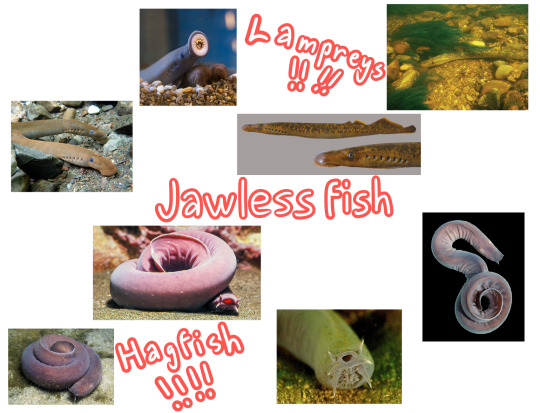
Jawless fish are often a topic of debate, especially in matters of their relation to each other and to jawed vertebrates. Evidence seems to point to hagfish and lampreys being closest related to one another and to lampreys being more closely related to jawed vertebrates than to hagfish (which would make hagfish craniates but not vertebrates). In the phylogeny tree above I decided to portray hagfish and lampreys as a monophyletic group, as molecular studies and microRNA analysis seems to point to a monophylegic superclass. Please note that this could go either way, though.
Jawless fish is a group containing two extant fishes, hagfish (class Myxini) and lampreys (order Petromyzontiformes)! Jawless fish are more "primitive" than other groups, for example both lack true vertebrae and scales. Still, they both have craniums and gills and they are aquatic, and so they have earned their place among fish!
Cartilaginous fish (class Chondrichthyes)
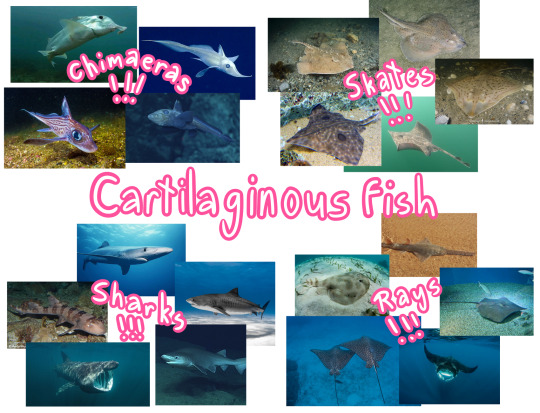
Surprisingly, I've found that this group has a lot of confusion surrounding it. I have received many a request confirming if sharks are fish, or asking if I'd cover a shark "even if it's not a fish". So I'll say it now: good news, sharks are indeed fish! So are their cousins, rays, skates and chimaeras, also known as ghost sharks! All of these fish have a primarily cartilaginous skeleton, tooth-like dermal denticles and lack gill covers and a swim bladder. Out of all the sharks, I also want to highlight that the whale shark, despite its confusing name, is a shark and not a whale. So, it is a fish!
Ray-finned fish (class Actinopterygii)
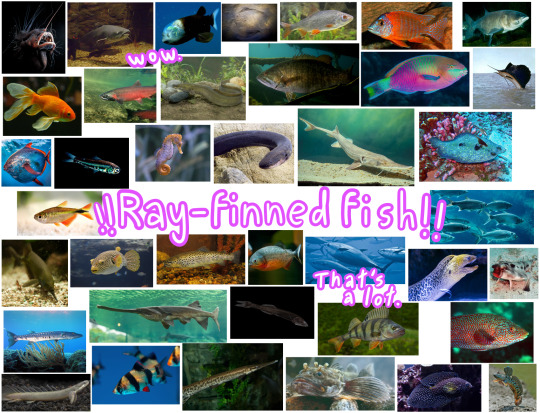
Name any fish, and there's a 96% chance the species name you said belongs to a ray-finned fish. Unless, like, you really like sharks. But this isn't about them.
Ray-finned fish are the biggest group of fish and incredibly diverse! It has your seahorse, your pufferfish, your bass, your tuna, your anglerfish, your clownfish, your salmon, your sturgeon, your lanternfish, your perch, your oarfish, your gar, your sardine, your moray eel... and this is only a tiny, tiny fraction of the groups that belong to this class! Defining features of ray-finned fish are that they tend to have a swim bladder and a bony skeleton (some exceptions though. Sturgeons, for one, have evolved a cartilaginous skeleton but they're still ray-finned fish). The largest group of ray-fins, the teleosts, also have leptoid scales, which are thinner and more flexible and grow with growth rings.
I want to bring special attention to some members of the ray-finned fish which tend to have a lot of confusion surrounding them and their heritage: eels and seahorses. Many people think these two are not fish due to their strange anatomy, like lack of scales or (many) fins and their elongated bodies, and I wouldn't blame them! Seahorses belong to family Syngnathidae, which also includes seadragons and pipefish. Eels, meanwhile, make up the order Anguilliformes. All of these long friends of ours are fish!
Lobe-finned fish (clade Sarcopterygii)

I shall merely focus on the fishy fishy fish individuals of this class, which excludes tetrapods. Lobe-finned fish house the two extant species of coelacanths, and six extant species of lungfish! These fish are bony and their fins are placed at the tips of fleshy, lobelike stalks, resembling the limbs of tetrapods. It is thought that the common ancestor of coelacanths and lungfish and tetrapods had similar structures that then became the four limbs the members of our clade typically have. Coelacanths and lungfish are wonderful fishes and deserve a lot of love and respect, not only because they're our closest cousins but because they're unique and we have so much to learn about them!
So, these are the fishes! There are also extinct groups of fish, namely class Placodermi (armoured fish) and class Acanthodii (spiny "sharks"). I'm moreso an extant fish account however, and so I shall move onto...
What isn't a fish?
Now we get into the real meat of this post. Without further ado, here are some aquatic friends of ours that can be mixed up with fish very often!
Crustaceans (subphylum Crustacea)
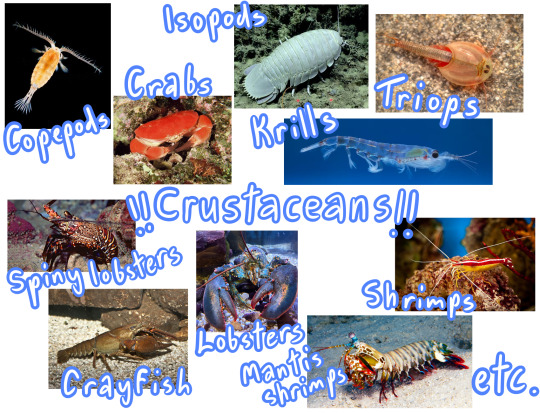
Many of our hard-shelled many-legged friends belong here! Crabs, lobsters, crayfish, shrimp, krill, isopods, triops, barnacles, copepods, you name it! Even though many crustaceans are aquatic or semiaquatic and have gills, you'll find that they're invertebrates that lack an internal skeleton (so no cranium, not even vertebrae)! We still love them though!
Mollusks (phylum Mollusca)

Creatures both soft and hard-shelled! Cephalopods like octopuses, squid, nautilus and cuttlefish, bivalves like clams, mussels, oysters or scallops, gastropods like sea slugs and snails and chitons go here! These friends of ours are also aquatic and have gills, some even have the suffix -fish (cephalopods used to be called inkfish, even!), but their lack of an endoskeleton is even more obvious than the crustaceans'. They're invertebrates, and therefore not fish!
Chelicerates (subphylum Chelicerata)
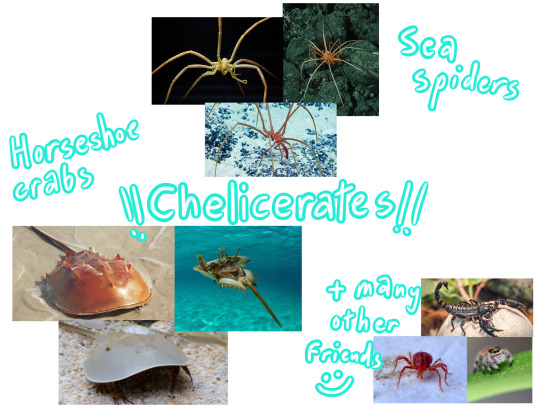
This group has many animals that are very hard to mistake for fish, namely spiders and scorpions, but horseshoe crabs and sea spiders are two groups of extant marine chelicerates! Both groups are aquatic, and horseshoe crabs have gills. However, they're both invertebrates, lacking a cranium or vertebrae. Other aquatic chelicerates exist, but they're usually very small, like water mites.
Cnidarians (phylum Cnidaria)

This phylum has the sessile corals and sea anemones and the usually more mobile jellyfish and siphonophores (includes the infamous Portugese man o' war!). I imagine corals and sea anemones are mistaken for fish less due to their sessile nature, but they're good to bring up nevertheless. None of these animals have a backbone, or, any bones really. They lack gills, they lack fins, they even lack the bilateral shape of fish. Jellyfish, despite the name, are indeed not fish! Some people suggest the name sea jellies be used for them instead, and I think it's much cuter.
Echinoderms (phylum Echinodermata)

Animals like starfish, sea urchins, brittle stars, sand dollars, sea cucumbers and feather stars go here. It seems that this pesky "-fish" -suffix is hard to shake off, as now we have the starfish. Once again, all of these slow-moving bottom-dwelling friends of ours are invertebrates, as they lack vertebrae or a cranium. Interestingly though, they are among our closest invertebrate relatives! So we ought to give them some props for that. I also want to mention that starfish can also be called sea stars, which ought to lessen confusion about their being too.
Comb jellies (phylum Ctenophora)

Comb jellies look a lot like jellyfish, but they belong in their own unique phylum! They have the same deal going on; they are invertebrates, they lack gills, they lack a cranium, they are simply aquatic.
Lancelets (subphylum Cephalocordata) and tunicates (subphylum Tunicata)
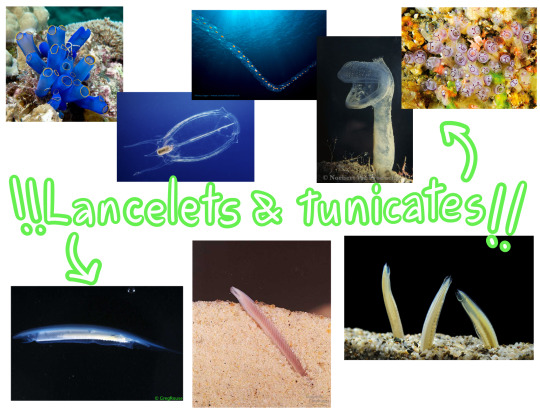
A double feature, because I wanted to save space didn't want these guys to be all alone! Lancelets and Tunicates, like sea squirts and salps, are chordates, which you can find in the phylogenic tree I drew all the way in the definitions section. They share many a feature with vertebrates, like a bilateral bodyplan, a notochord at some stage of life and a post-anal tail, but I'm afraid they're still not fish. They lack a cranium and their notochord does not develop into a vertebral column! Sorry friends, you tried. We can still hang out at the chordate convention.
Annelids (phylum Annelida)

The infamous bobbit worm, bone-eating worms, sea mice, giant tube worms, feather duster worms, spoon worms, bristleworms in general, leeches... many, many worms go here! Pretty self-explanatory: they are invertebrates, even when they live in water. They're extremely cool invertebrates too! I suggest taking a look at some of them, there's many interesting species.
Flatworms (phylum Platyhelminthes)

Flatworms are another very diverse group of worms, having many species both terrestrial and aquatic, however mostly I want to put attention into the free-swimming marine flatworms. They may swim beautifully (and fence with grace), but they are nevertheless invertebrates! Flatworms can live a variety of different lifestyles, from predators to parasites.
Amphibians (class Amphibia)

We've made it into vertebrates now! Amphibians include frogs, salamanders, and caecilians. While they have limbs with digits in their adulthood*, they can be easily confused for fish in their larval stages! This is no surprise, as they use gills to breathe underwater and tadpoles lack any limbs at all for a while. Many amphibians later transition into a terrestrial or semiaquatic way of life and lose their gills, not to mention gain their digit-having limbs.
(*excluding caecilians)
...Well, many amphibians do this, but not all. It's important to mention there are also species of aquatic salamanders which can bear great resemblance to fish with their elongated bodies! Amphiumas, which are sometimes mistakenly called "conger eels" (which is an actual species of fish), are aquatic salamanders with small residual limbs and both working gills and lungs. Giant salamanders and mudpuppies/waterdogs have lungs and gills as well, and lead an aquatic lifestyle — olms are close relatives of mudpuppies. Sirens, meanwhile, lack hind limbs and only have small front limbs, along with retaining their gills in adulthood. Among aquatic salamanders I also want to bring up one most often talked about species: the axolotl! They remain in their larval form, have external gills and lead an aquatic lifestyle. It can be hard to tell with aquatic salamanders sometimes, but these friends of ours are amphibians and not fish, even if they've rejected the land life.
Caecilians are a bit less known overall, but they can also cause a lot of confusion due to their long, limbless body. While most caecilians live underground, some are aquatic in nature, and can therefore be mistaken for fish! However, caecilians breathe via the use of their lungs and through the skin and don't have any gills at all.
Reptiles (class Reptilia)

Most commonly mistaken for fish in this group are sea snakes, sea kraits and water snakes, sea turtles, turtles, penguins, and other (semi)aquatic birds. Sea snakes and water snakes bear a very strong resemblance to eels, but they are indeed just snakes adapted to an aquatic or a semiaquatic lifestyle! The same goes for sea turtles, turtles overall, and penguins. They all need to breathe air and they lack fins, even if their flippers, webbed feet and built-in paddles may look like fins! They also have wholly different types of scales (or feathers!!) than what fish have, even if they share the feature. I assume that other aquatic reptiles, like the marine iguana and crocodilians are better read as reptiles thanks to their limbs with digits, but I want to give them a reptile shoutout anyway. They’re aquatic or semiaquatic, but they are air-breathers and fin-lackers all the same!
I also want to mention one specific extinct group of reptiles, ichtyosaurs! These marine reptiles were rather shark- or dolphin-like in appearance, which is actually a really good example of convergent evolution! Like all other reptiles, they also needed to breathe air and they had... erm... well, I'm not sure if I can call the bones in their flippers digits, but, that's what they used to be, so...? They were cool reptiles and among my favourites! There were many other aquatic reptiles too, but I will only mention just the ones now. A paleontology account would be better-suited to list you allll the marine reptiles.
Mammals (class Mammalia)

Our home class! Some of the aquatic friends we have in this class include whales like baleen and beaked whales, dolphins (orcas go here), porpoises, belugas, narwhals and sperm whales, pinnipeds like seals, sea lions, walruses, and sirenians like manatees, (occasionally known as sea cows) and dugongs! We also have some semiaquatic buddies like hippopotamids, otters, beavers and platypuses! Whales and pinnipeds especially often cause a lot of confusion due to their very streamlined, fishy appearance. They are, however, air breathers that feed their young with milk (some dolphin calves are even born with some hair), and their ancestors were land mammals! The same goes for pinnipeds and sirenians too. True seals, fur seals and sea lions still have fur even! Hippos, otters, beavers and platypuses are a bit more obvious as mammals with their fur and.. distinct air-breathing.. but I wanted to mention them anyway. Their adaptations to aquatic life are just one example of how fascinating evolution can be!
And here we are! A hopefully comprehensive list of fishes and non-fishes, beginning with the ever-shifting story of the term "fish", phylogeny, and why some animals are called fish when they really aren't. I hope you have found useful and interesting information in this post, and perhaps learned something new! I bid you a farewell! :D
#fish guide#fish essay#fish#fish facts#fishfact#marine biology#biology#zoology#long post#jawless fish#cartilaginous fish#ray-finned fish#lobe-finned fish
257 notes
·
View notes
Text




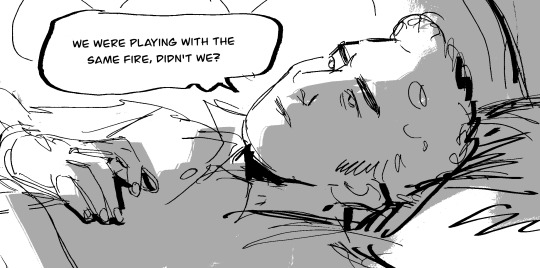
// ASK RISORGIMENTO ITALY CONTINUES! // ASKBOX OPEN AGAIN
Risorgimento, meaning "resurrection," was the term used as early as the 1840s to describe the aspirations to Italian independence that would finally be achieved between 1859 and 1870.
87 notes
·
View notes
Text
Lingthusiasm Episode 89: Connecting with oral culture
For tens of thousands of years, humans have transmitted long and intricate stories to each other, which we learned directly from witnessing other people telling them. Many of these collaboratively composed stories were among the earliest things written down when a culture encountered writing, such as the Iliad and the Odyssey, the Mwindo Epic, and Beowulf.
In this episode, your hosts Gretchen McCulloch and Lauren Gawne get enthusiastic about how writing things down changes how we feel about them. We talk about a Ted Chiang short story comparing the spread of literacy to the spread of video recording, how oral cultures around the world have preserved astronomical information about the Seven Sisters constellation for over 10,000 years, and how the field of nuclear semiotics looks to the past to try and communicate with the far future. We also talk about how "oral" vs " written" culture should perhaps be referred to as "embodied" vs "recorded" culture because signed languages are very much part of this conversation, where areas of residual orality have remained in our own lives, from proverbs to gossip to guided tours, and why memes are an extreme example of literate culture rather than extreme oral culture.
Read the transcript here.
Announcements:
We've created a new and Highly Scientific™ 'Which Lingthusiasm episode are you?' quiz! Answer some very fun and fanciful questions and find out which Lingthusiasm episode most closely corresponds with your personality. If you're not sure where to start with our back catalogue, or you want to get a friend started on Lingthusiasm, this is the perfect place to start. Take the quiz here!
Here are the links mentioned in the episode:
The 'Which Lingthusiasm episode are you?' quiz
'The Truth of Fact, the Truth of Feeling' by Ted Chiang
'The Truth of Fact, the Truth of Feeling by Ted Chiang — Subterranean Press' blog post by Devon Zeugel
'Orality and Literacy' by Walter J. Ong
Wikipedia entry for Grimms' Fairytales
Wikipedia entry for Milman Parry
Wikipedia entry for Homeric Question
Wikipedia entry for Mwindo Epic
Encyclopedia.com entry for Mwindo
Crash Course episode 'The Mwindo Epic'
'The world’s oldest story? Astronomers say global myths about ‘seven sisters’ stars may reach back 100,000 years' by Ray Norris on The Conversation
'The Pleiades – or 7 Sisters – known around the world' by Bruce McClure on EarthSky
Wikipedia entry for Nuclear Semiotics
99% Invisible episode 'Ten Thousand Years'
Wikipedia entry for Aesops Fables
'How Inuit Parents Teach Their Kinds to Control Their Anger' by Michaeleen Doucleff and Jane Greenhalgh for NPR
Deafness and Orality: An Electronic Conversation
Wikipedia entry for The Tale of Genji
Bea Wolf, a middle-grade graphic novel retelling of Beowulf, by Zach Weinersmith
Lingthusiasm episodes mentioned:
'Writing is a technology'
'Arrival of the linguists'
How translators approach a text'
You can listen to this episode via Lingthusiasm.com, Soundcloud, RSS, Apple Podcasts/iTunes, Spotify, YouTube, or wherever you get your podcasts. You can also download an mp3 via the Soundcloud page for offline listening.
To receive an email whenever a new episode drops, sign up for the Lingthusiasm mailing list.
You can help keep Lingthusiasm ad-free, get access to bonus content, and more perks by supporting us on Patreon.
Lingthusiasm is on Bluesky, Twitter, Instagram, Facebook, Mastodon, and Tumblr. Email us at contact [at] lingthusiasm [dot] com
Gretchen is on Bluesky as @GretchenMcC and blogs at All Things Linguistic.
Lauren is on Bluesky as @superlinguo and blogs at Superlinguo.
Lingthusiasm is created by Gretchen McCulloch and Lauren Gawne. Our senior producer is Claire Gawne, our production editor is Sarah Dopierala, our production assistant is Martha Tsutsui Billins, and our editorial assistant is Jon Kruk. Our music is ‘Ancient City’ by The Triangles.
#language#linguistics#lingthusiasm#episodes#podcast#podcasts#episode 89#orality#literacy#fairy tales#myths#epics#oral culture#Ted Chiang#Homer#Mwindo#nuclear semiotics#ray cats#quiz#personality quiz#SoundCloud
79 notes
·
View notes
Text
Lurking on other people's conversation on Twitter, and woah I didn't know this
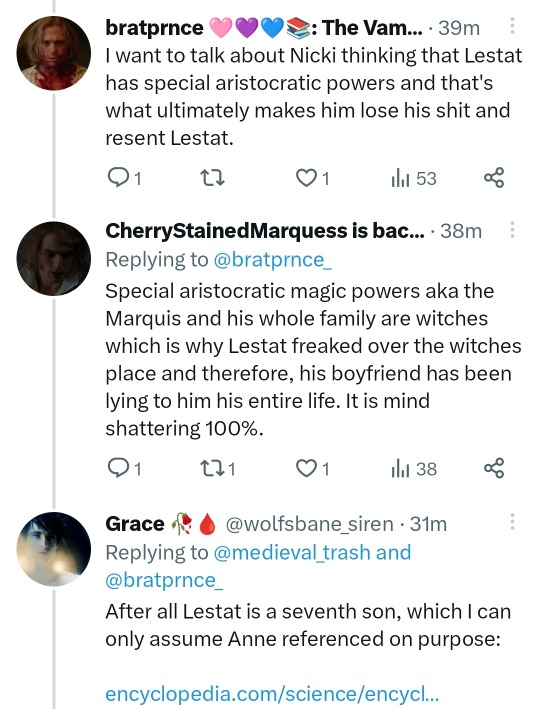

#lestat de lioncourt#the vampire chronicles#interview with the vampire#iwtv#this gives shounen manga protagonist energy#moi.txt
368 notes
·
View notes
Text
A little Naval History Beginners Guide
Books I like to recommend because they are really well written, have a high information content and I personally work with them. This is only a small list, there are of course many more, but for a start these are good to begin with.
B. Lavery, Nelson’s Navy. The Ships, Men and Organisation. 1793-1815 New Edition (London 2012)
B. Ireland, Naval Warfare in the Age of Sail. War at Sea 1756-1815 ( London 2000)
N. Tracy, Nelson’s Battles. The Art of Victory in the Age of Sail (London 1996)
D.Davies, A brief history of Figthing Ships (London 1996)
A. Lambert, War at Sea in the Age of Sail 1650- 1850 (London 2000)
G. Wells, Naval Customs and traditions (London 1930)
P. Goodwin, HMS Victory, Pocket Manuel 1805 (London 2015)
J. Eastland a. I. Ballantyne, HMS Victory. First Rate 1765 (London 2011)
J. Bennett, Sailing into the Past. Learning from replica Ships (London 2009)
M. P. Smith, Terror at Sea. True Tales of shipwrecks, cannibalism, pirates, fire at sea & otherdire disasters in the 18th& 19th centuries (Maine, 1995)
J. Lowry, Fiddlers and whores. the candid memoirs of a surgeon in Nelson’s fleet, James Lowry, 1798 (London 2006)
B. Lavery, Royal Tars. The lower deck of the royal navy, 875-1850 (London 2010)
R. and L. Adkins, Jack Tar. Life in Nelson’s Navy (London 2008)
A. Bruce, Encyclopedia of Naval History (London 1998)
J. Black, Naval Power: A History of Warfare and the Sea from 1500 (London 2009)
N.A. M Rodger, The Safeguard of the Sea: A Naval History of Britain 660-1649 (London 1997)
C. L. Symonds, The U.S. Navy: A Concise History (New York 2015)
https://naval-encyclopedia.com/
C. G. Davis, American Sailing Ships: Their Plans and History (University of Michigan 1984)
B. Greenhill, The Evolution of the Wooden Ship (1988)
R. Woodman, The History of the Ship: The Comprehensive Story of Seafaring from the Earliest Times to the Present Day (1998)
Admiral W. E. Smith, The Sailor's Word-Book: An Alphabetical Digest of Nautical Terms (England 1867)
128 notes
·
View notes
Text

Image ID: a screenshot of the hiberno-english entry in encyclopedia.com that has 3,967,691 views and has the logo of the oxford university press. it reads: HIBERNO-ENGLISH. A VARIETY of English in Ireland, used mainly by less educated speakers whose ancestral tongue was IRISH GAELIC. It is strongest in and around the Gaeltachts (Irish-speaking regions) and in rural areas. It preserves certain Gaelic... Screenshot ends. End ID
I literally made this same post last year and it's still up like. "spoken by the lesser educated" it's spoken by almost everyone in Ireland you weird classist english fucks. colonialist british empire mentality alive and well i see... Hiberno-english is literally so much nicer sounding than english english anyway. "ancestral tongue" "Irish gaelic" Labhraím GAEILGE inniu tusa liúdramán
#ireland#irish#hiberno-english#gaeilge#linguistics#im actually not even that mad because im not surprised one bit#english people especially english people affiliated with oxford or any of them elite universities will never not be weird about#irish languages/dialects#or the languages/dialects of any of their former/current colonies#mad that the whole planet isn't speaking “queens english” ig#i spelt labhraím wrong oh kill me
60 notes
·
View notes
Text
Hihi! Would you be perchance be interested in some surely-not-fishing-links?
protonmail.com - an encrypted email service based in switzerland
deepl.com - a translator utilising AI. Though it only features a handful of languages
openstreetmap.org - a geographic database openly mantained by communities
tineye.com - a reserve image search engine
qwant.com - a privacy focused search engine hosted in france
encyclopedia.com - an online encyclopedia
37 notes
·
View notes
Note
Biology says life doesn't begin at conception and that it is an endless continuum. Really gotta stop making absolutist statements.
Once again, you are wrong. The vast majority of biologists (95%) say that life begins at fertilization. The "debate" is about when a human life is developed enough to qualify as a "real person", ie, the personhood debate. And the only consistently moral answer to that question is also "when life begins", which is conception. Any other answer splits humanity into "real people deserving of rights" and "non-persons who have no rights". And once you start splitting human beings up like that, you tacitly, if not explicitly, endorse that possibility for any group of humans. Either you believe all humans have human rights, or you don't believe in human rights. There is no middle ground, here.
31 notes
·
View notes
Video
May the Fourth be with you by Rob Finch
Via Flickr:
Sporting a 'SAC' sash, US Air Force Rockwell B-1A Lancer 76-0174 preserved USAFM Dayton Ohio After a protracted development gestation and eventual cancellation by President Carter, testing was allowed to continue and the B-1A was eventually revamped as the B-1B which entered service serving in parallel with the B-52 - augmented by the B-2 'Spirit' stealth Bomber 76-0174 was the fourth and last B-1A built and was used as a test bed for the B-1B programme plane-encyclopedia.com/cold-war/rockwell-b-1a-lancer/ Scanned Kodak 35mm Transparency
17 notes
·
View notes
Note

I'm sorry forensics (/pos)?? I love forensics, I'd love to hear a rant omg
Yeah!!! Okay, so I’ve ranted about most of what I remember, but I do have more info on time of death stuff!! (Please note I’m not a professional and a lot of this is from limited research and what I remember)
Tw Gore, Death, Blood, Decay, insect mention Under cut
So there are a couple of ways to determine an estimate for the time of death.
You gotta remember that many of these only provide a frame of estimated time and factors might throw it off anyways.
The first is using Algor Mortis (ambient temperature vs the temperature of the body.) This only works if the body is NOT the same as the ambient temperature and the ambient temperature is LOWER than the Body temperature. Most bodies have an average temperature in the mid 90’s and after death there’s nothing to keep it at that temperature. Therefore, it slowly loses a couple of degrees every hour. Usually this can only be used for the first 24 hours after death.
The second is the sodium-potassium content in the eyes. So there are little pumps in your eyes that regulate the amount of sodium in your eyes. Once you die, they stop working and amount of sodium will gradually change. This is also pretty predictable and the rate of change is what allows for an estimate.
There’s Rigor mortis with how fast the body stiffens and the have the muscles decompose. Depending on the ambient temperature the amount of time spent in rigor mortis can be more or less than the standard 3 hours.
Then there’s Liver Mortis which is the discoloration of the skin after the blood settles in the blood vessels due to gravity. It usually sets in 2-3 hours after death and sets itself after 12 hours. (Remember temperature can speed this up or slow it down.) This can also be used to determine the cause of death sometimes! Bright red liver mortis is usually caused by Carbon Monoxide poisoning! (Please check the batteries on your CO monitors.)
Then there’s the stage of decomp that the body is in, what bugs are found on/in the body, and evidence that is found outside of the body (text messages, fitbits, last sighting, etc etc etc)
This is where I checked most of my info with :>
#forensics#speck rambles#🐊#I love ranting!#i can’t wait to go back to my studies tbh#tw blood#tw death#tw decay#tw insects#tw gore
6 notes
·
View notes
Text

Charles Lane. Master character actor. I have his autograph.
(Born Charles Gerstle Levison)
January 26, 1905 – July 9, 2007 Age 102)
Charles Lane was an American character actor and centenarian whose career spanned 72 years. Making his film debut in City Girl (1930), Lane appeared in more than 250 films and hundreds of television shows. Lane appeared in many Frank Capra films, including Mr. Deeds Goes to Town (1936), You Can't Take It with You (1938), Mr. Smith Goes to Washington (1939), Arsenic and Old Lace (1944), It's a Wonderful Life (1946) and Riding High (1950). His final acting role was at the age of 101 in 2006's The Night Before Christmas.
In 1931, Lane married Ruth Covell, and they remained together for 70 years until her death in 2002. They had a son, Tom, and a daughter, Alice. Despite his stern, hard-hearted demeanor in most of his film and television roles, friends and acquaintances have unanimously described Lane as a warm, funny, and kind person. On July 9, 2007, Charles Lane died peacefully of natural causes at his Brentwood, Los Angeles, California home. He was 102 years old.
NOTE: Sources include Encyclopedia.com, IMDb, and Wikipedia.

7 notes
·
View notes
Photo

1943 01 Panzer II Ausf J 12 Panzer Division - W. Catapult - Bronco Models
https://tanks-encyclopedia.com/ww2/germany/panzer-ii-ausf-j
18 notes
·
View notes
Text
Divination method: Extispicy
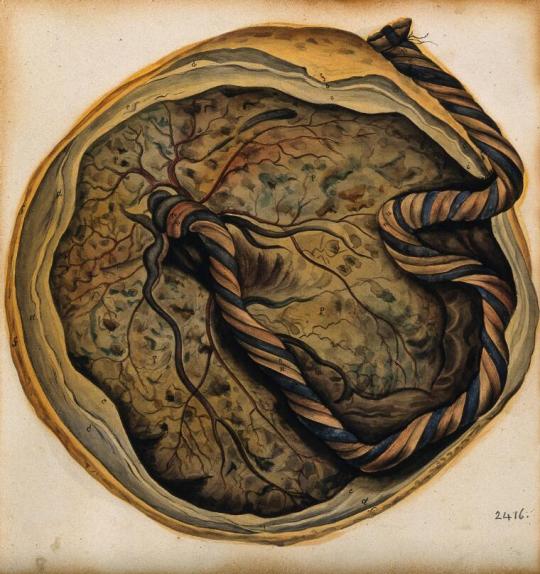
image source
From latin extispex (diviner of entrails) + -ium (forming abstract nouns)
Extispicy (also known as haruspicy) is a divination method that foretells the future by interpreting a dead animal’s entrails. Similar to anthropomancy, the animal is ritually sacrificed in order to have its insides divined.
The diviner interprets the organ’s color, shape, firmness, texture, anomalies, vessel configuration (typically interpreted as a map) and corpse’s sounds and odors. Traditionally, the diviners looked for signs in the liver (hepatoscopy/ haruspicy), placenta (amniomancy), bodily fluids (drymimancy) and blood (hematomancy). Depending on the ritual, other organs would be divined as well.
After the ritual, the animal's meat is consumed and the leftovers repurposed.
For more information:
encyclopedia.com
britannica.com
#divination#occult#magic#witchcraft#spirituality#metaphysics#mysticism#extispicy#haruspicy#sacrifice#ritual
5 notes
·
View notes
Text
One-Sex Theory | Encyclopedia.com
"The term one-sex theory refers to the belief that there was only one sex and it was male. The theory originated in the writings of Aristotle and Galen; they had postulated a structural homology between the sexual organs of men and women whereby they were basically the same, except that those of men lay outside the body while those of women lay inside it and were, naturally, reversed: a vagina was a penis turned inside, the ovaries were the testicles, and so on. Similarly, bodily fluids (semen, blood, milk) were basically the same, being composed of the same fungible matter. The difference between men and women was not, therefore, one of kind (two different types of beings), but of degree (various types of the same being).
The theory postulated that, in the final stages of gestation immediately preceding birth, heat drove the sexual organs out of the fetus's body and created a man; should there not be enough heat, an incompletely formed male (that is, a female) would be born. According to this model, females were thus imperfectly formed males, with all the social and cultural consequences that followed, including exclusion from the highest ecclesiastical, political, or intellectual positions in their society, subservience and obedience to male kins, severe restrictions in legal and economic matters, and so forth.
that if, at puberty, sufficient heat were applied, a "girl" could force her sexual organs out of her body and become a "boy." In the sixteenth century, anecdotal accounts attesting to such transformations abound. One of the most famous is the case of Marie, a French shepherdess from Vitry-le-François who, at age fifteen, while chasing some pigs in the heat of the summer, jumped over a small creek and, landing heavily on the other side, so ruptured her ligaments that her sexual organs fell out and she instantly became a man, Germain, who then lived as a male for the rest of his life. The story is recounted by, among others, the physicians Jacques Ferrand and Amboise Paré, and the philosopher Michel de Montaigne (1533–1592). Other stories, such as the one told by a certain Antoine Loqueneux to Amatus Lusitanus (1511–1568), attribute the change to the "heat of passion"—a girl in bed with a chambermaid is so sexually aroused that she suddenly ejects a male member from her body and carries on life (and, one assumes, sexual activity) as a male.
In his groundbreaking volume Making Sex: Body and Gender from the Greeks to Freud (1990), Thomas Laqueur highlights this theory and suggests that it was the fundamental operative model for understanding sex and sexuality not only in the Renaissance but even as far as the eighteenth century. A chorus of scholars (Katherine Park, Robert Nye, Michael Stolberg, and Donald Beecher, among others) have argued strongly against it, however, pointing out that already by 1600 the Aristotelian-Galenic one-sex model had been completely debunked and abandoned not only by European thinkers but, more importantly, by the medical profession itself. Its reaffirmation by Laqueur and others in the late twentieth century is, according to some, more grounded in contemporary theoretical battles than in the realities of Renaissance culture or science."
I can't believe people actually believed this and that it was around during the time of Shakespeare. There absolutely are some men in this world so in love with themselves, they want to actually erase women. What happened at John Hopkins is no accident. This idiotic theory has been around for hundreds of years, but has already been debunked. They've tried to bring it back, anyway.
1 note
·
View note
